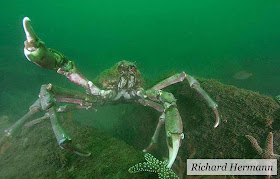Who else is excited about the Super Bowl this year? I'm a Bears fan (just like blue crabs - see here), but my Long Islander husband also roots for the Giants, so we're pretty pumped to see the Giants play the Patriots again! (For those of you who aren't so American football oriented - the Giants beat the Patriots in 2008, so this will be an exciting rematch!)
OK, enough about that. We all know the second most exciting thing about the Super Bowl is the food! (I used to think it was the commercials, but they've kind of gone downhill.) So what am I making? I've been searching around the wonderful world of Pinterest and finding lots of ideas:
I can't decide! I'm thinking of either making Hot Crab Dip or Crab-Stuffed Jalapeños. It depends on the quality of jalapeños we can get up here; sometimes they're really fresh but other times they look 1 day shy of becoming jalapeño soup.
I'll let you know what I pick later, but here are both recipes for your cooking pleasure:
I'll let you know what I pick later, but here are both recipes for your cooking pleasure:
Hot Crab Dip
from Adryon's Kitchen
Ingredients
8 oz. plain cream cheese
8 oz. chive and onion cream cheese
2 Tablespoons mayonnaise
1 cup of shredded cheddar cheese
1 teaspoon Old Bay® Seasoning
1/2 teaspoon Worcestershire sauce
1/2 teaspoon horseradish - this is what drew me in!
6 oz. non-lump crab meat
8 oz. jumbo lump crab meat
Directions
1. Preheat oven to 350 degrees F.
2. In a large bowl, mix the cream cheeses, mayonnaise and cheddar cheese thoroughly. (We sometimes use our Cuisinart to whip cream cheese for extra fluffiness.)
3. Sprinkle in the Old Bay®, good ol' Worcestershire (any Two Fat Ladies fans out there?), horseradish, and the 6 oz. of non-lump meat. Mix until combined. Then gently fold in the lump crab meat.
4. Empty the bowl into an oven-safe dish that can ideally hold 4 cups worth of goodness. Cover the dish with aluminum foil and place in the oven. Cook for 40 minutes, uncovering half way through, or until the top of the dish is golden brown and bubbly.
5. Let it rest for about 10 minutes so you don’t burn your mouth. Adryon suggests to serve it with crusty bread or celery and carrots. She also says that if you prepare it a day in advance, then bake it the day-of, the flavors are that much better!
2. In a large bowl, mix the cream cheeses, mayonnaise and cheddar cheese thoroughly. (We sometimes use our Cuisinart to whip cream cheese for extra fluffiness.)
3. Sprinkle in the Old Bay®, good ol' Worcestershire (any Two Fat Ladies fans out there?), horseradish, and the 6 oz. of non-lump meat. Mix until combined. Then gently fold in the lump crab meat.
4. Empty the bowl into an oven-safe dish that can ideally hold 4 cups worth of goodness. Cover the dish with aluminum foil and place in the oven. Cook for 40 minutes, uncovering half way through, or until the top of the dish is golden brown and bubbly.
5. Let it rest for about 10 minutes so you don’t burn your mouth. Adryon suggests to serve it with crusty bread or celery and carrots. She also says that if you prepare it a day in advance, then bake it the day-of, the flavors are that much better!
Ingredients
10–12 medium jalapeños
1/4 lb lump crab meat
3 tbsp cream cheese, at room temperature
1 tbsp finely chopped cilantro leaves
1 tbsp finely chopped parsley leaves
1 shallot, finely chopped
1 1/2 tbsp plus 3/4 cup dried bread crumbs
2 tsp fresh lime juice
1/2 cup all-purpose flour
1/2 cup milk
2 eggs, beaten
Directions
1. Preheat oven to 350 degrees F. Lightly grease a baking sheet and set aside.
2. Cut off the tops and halve each jalapeño. Remove the seeds if you want (and remember, the pith holds a lot of heat, but if you want to remove that too you should probably just stop eating jalapeños).
3. Mix together crab, cream cheese, cilantro, parsley, shallots, 1 1/2 tbsp bread crumbs, and lime juice in a bowl. Stuff each jalapeño with about 1 tbsp of filling; transfer to a plate.
4. Put remaining bread crumbs into a shallow dish. Put flour into another small dish. Whisk together milk and eggs in a bowl. Dredge each jalapeño in flour, shaking off excess. Dip jalapeño in egg mixture, roll in bread crumbs, and transfer to a baking sheet, cut side up.
5. Bake jalapeños for 30 minutes or until golden brown and bubbly on the inside. I got the baking modification from Emeril Lagasse's "Baked, Not Fried" episode, and he suggests you serve these bad boys immediately with a cold beer. But it's up to you.
Emeril's baked poppers look delicious,
but imagine how much better they'd be with crab!
What are YOU going to make for Super Bowl Sunday?
UPDATE!!!
I went with the crab dip, and my honest opinion: it needs WAY more horseradish. Maybe it's my Polish side, but I doubled the amount of horseradish used (it was what drew me in, after all) and I still couldn't taste it in the finished product. Next time I may go with a different dip entirely, but if I do I'll be sure to share the recipe with you!

































